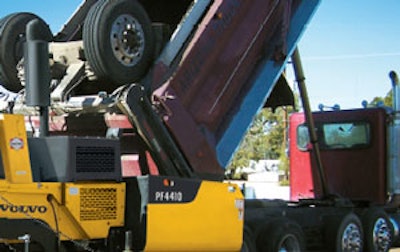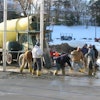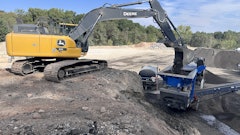
Information provided by Volvo Construction Equipment
From delivery of HMA at a site to finish rolling, every asphalt paving project involves a choreographed sequence of responsibilities. Given that the time available for compaction (TAC) can be as little as 10 minutes in some circumstances, the role of each paving crew member is extremely vital to a successful HMA project.
The following are general descriptions of each of the main crew positions on a typical HMA project.
Truck driver
Put simply, the truck driver's role is to make sure the HMA gets from the pug mill (i.e., mixing drum) to the paving operation efficiently. But there's more to the task than merely driving. The driver must first load the truck, making sure to use at least three load placements to ensure a homogenous mass and to avoid segregation of the mix.
Once on the site, the driver backs the truck into position and aligns it with the material transfer vehicle (MTV), paver or windrow. As the paver or MTV moves forward and makes contact with the truck or trailer tires, the truck driver opens his tailgate and discharges the mix. He will then follow the instructions of the dump person, the paver operator or MTV operator as he adeptly inches his truck forward in sync with the equipment behind him. With his load delivered, the truck driver pulls away, cleans any residue from his vehicle and returns to the plant for another load.
Dump person
In addition to watching for possible safety hazards such as overhead power lines or obstructions, the dump person's role is to direct the truck into proper position for discharging HMA into an MTV or a paver, or onto grade for a windrow. He or she will clearly communicate important information to the truck driver, such as when to change truck bed position, mix discharge rate, and any other information that helps prevent segregation. He or she will also let the driver know when to pull away.
When mix is being unloaded directly into a paver, the dump person makes sure the mix level in the hopper is within parameters - typically no less than one-third full. The dump person will also use an infrared thermometer to monitor mix temperature for uniformity.
MTV operator
The MTV operator is responsible for receiving HMA from the haul trucks into the MTV, and then transferring it to the paver. The MTV operator communicates with the paver operator, truck driver and dump person to make sure the MTV is in the best position for feeding a continuous, uniform flow of HMA into the paver and that the paving train is moving at a steady speed.
Paver operator
During placement, the paver operator communicates with the truck driver, MTV operator (or dump person) and the screed operator to ensure the paver stays at a speed that balances mix delivery, lay-down capacity and compaction. He keeps the paver moving at a uniform speed, avoiding extended stops. He must steer the paver smoothly and maintain the predetermined reference line to achieve the optimal panel edges and transitions. If the paver is stopped and started again during placement, the operator should do this smoothly and quickly to avoid surface irregularity or roughness.
Screed operator
Screed operation is critical to a successful paving job; the operator needs to understand all the functions and operating characteristics of the type of screed being used (e.g., free-floating, self-leveling) in order to produce high-quality longitudinal and transverse joints. He must also be aware of HMA mix characteristics and their effect on the paving process.
As the mix is being placed, he must continually monitor the texture of the paving surface and, if necessary, adjust the screed to ensure the desired mat texture. He keeps in constant communication with the paver operator to establish and maintain a uniform head of material within a 1-inch (25 millimeters) tolerance.
Breakdown compactor operator
Once the HMA is placed, it is the breakdown compactor operator's responsibility to achieve target pavement density within the TAC by rolling over the mix at the proper temperature for air void reduction without risk of damaging the aggregate. This is accomplished, in part, using an infrared sensor to monitor pavement surface temperature.
The operator maintains an appropriate distance behind the paver. He follows a pre-established rolling pattern, and performs the correct number of rolling passes to achieve uniform pavement density and remove marks from the pavement surface.
Finish compactor operator
Finish rolling is performed to remove all pavement surface blemishes and other marks created by the breakdown and intermediate rolling phases. It's also performed when breakdown and intermediate rolling fails to achieve target density within the TAC.
Ground crew
No paving operation is complete without an attentive ground crew. Their job is to make sure the HMA pavement surface is ready for compaction. Using lutes, rakes, and shovels, the crew will clean up any spillage between the truck, the MTV, and the paver. They will monitor the pavement closely and remove any chunks or foreign materials, and they'll hand-work any portion of the placed mix that can't be placed properly by the screed. The ground crew will also help prepare equipment for operation before a shift and help clean it afterwards.
While some of the crew positions on an HMA paving project require more skill, experience and training than others, every member of the crew plays an integral role. Through a clear understanding of their individual responsibilities, diligence during the shift and good communication with one another, the crew will be better prepared for a successful project.















